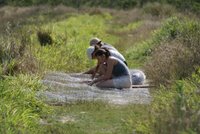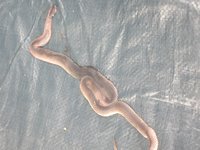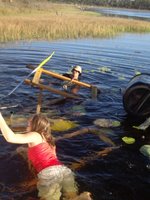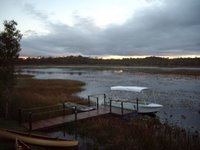After a couple of months coordinating the crocodile project, I begin to think that Murphy must have developed his well known Law while trying to run a conservation project in far north Queensland. Not only does everything go wrong that can go wrong but a few things that couldn’t possibly go wrong, go wrong as well.
On my first planned capture expedition my vet falls sick and the whole event has to be cancelled; my contact from Queensland Parks and Wildlife has disappeared on long-service-leave, resulting in an obstacle course of red tape to get my permit sorted; my mobile phone takes a swim in the lagoon, leaving me largely uncontactable at critical moments; and the mighty Jackaroo starts a weekly trend of breaking down at the most inopportune of moments.
I am in fact on the verge of admitting defeat when a few faint rays of light push through the clouds. Just as my permit issues are finally sorted, a bloke from Parks and Wildlife becomes available to join a capture run and my vet is suddenly fighting fit once again.
To top things off, the local Holden dealer in Mareeba manages to plug the fuel leak in the Jackaroo (a job three mechanics in Cairns have previously charged me several hundred dollars to fail to do). In the space of four days, I go from almost cancelling the project to standing waste deep in a murky billabong, gingerly unsnagging a net from a rock while an entangled, angry crocodile twists and thrashes in front of me.

The capture site is on a remote cattle station called Karma Waters, found downstream of the Mareeba Wetlands along the mighty Mitchell River. The owners, down-to-earth country folk, are friends of the Mareeba Wetlands and kindly let us use their property. I suspect however, that there is a fair amount of head shaking, when they see us city-slickers coming to splash about and make a fuss over a couple of little freshwater crocodiles. They’re too polite to make comment however, and they leave us to our foolery while they carry on with the real work of herding cattle, mending fences and patching roads before the onset of the Wet.
The only road into Karma Waters is dirt for 50kms and there’s no local supermarket to duck down to and grab supplies from. The capture expedition is a three day event, with tents and swags and campfire cooking. As well as the two Wardens from the Mareeba Wetlands, I manage to recruit two volunteers for the expedition.
My two volunteers are mates travelling together: Jon is a Londoner and a labourer by trade with the tattoos to prove it; Glen is a solid Maori bloke and easily mistaken for a building with legs. Glen eats everything in sight and within the first few hours at the camp he’s devoured half our rations for the trip. I end up giving him a box of cornflakes to eat from just to stop him polishing off the rest of our supplies.
Our first day is spent making camp and scouting out the local area. It’s a picturesque location, with a fresh, flowing river meandering its way through a sandy riverbed beneath the shade of some low-hanging paper-bark trees. Driftwood however, caught high in the branches of some trees, gives a telltale sign of the anger this river is capable of in the Wet.
The freshies are elusive and incredibly shy but I do catch a glimpse of one scuttling into the river at our approach. We hear plenty more drop from the banks into the safe, dark depths of the river. At night, spotlighting reveals numerous sets of eyes reflecting back at us with a dull red flame, like the eyes of small sinister devils sliding slowly through pools of blackness. Few humans visit the area and the freshies hold dominance over all but the abundant cane toads. Cane toads answer to no higher force.
Our vet and Brian, the Parks and Wildlife bloke, join the team early on the second day and after they arrive we head out with the capture gear. Unfortunately the water levels in the river are too high to allow for any practical or safe netting to be carried out. The two cyclones earlier in the year and the continued patchy rain have seen to that. With the river too high to be worked, we’re left only with the nearby billabongs to catch our crocs from.
We stroll out to the billabongs, lugging heavy nets and medical supplies for both humans and crocodiles. On the way Brian provides us with useful information about crocodiles and how we will be catching and transporting them. Glen however, is only interested in finding out whether Brian has ever eaten any and what they taste like. The two Wardens, bird watchers to the core, are constantly distracted by birds ducking past and Glen is equally interested in how each of these would taste too.

We reach the first waterhole. It’s fairly small, only ten meters wide and around thirty meters long. We stretch the net across one bank and then two people on each end drag the net in a U-shape towards the far shore. It’s an effective technique but it does have one drawback: the net constantly catches against any snags in the billabong. So this is the job allocated to my volunteers, the Wardens and myself. We enter the water behind the net and anytime it snags we have to reach down into the murky water and unsnag it.
About halfway through the drag the floats go under and something large wraps itself up in the net. The occasional scaled limb lifting out of the water confirms that it’s a croc; a big one. We continue quickly to the shore and as we move, a few more animals hit the net. Our unsnagging becomes a little more careful as there’s no telling what’s in the net in front of us as we reach down to unhook the net from whatever rock or log it’s caught on.
With the net up the shore we check our catch. We have two crocs and a handful of turtles. We quickly disentangle the turtles and release them back into the waterway. We then turn to our crocs. We tape their jaws shut using duct tape and blindfold them as well to reduce stress. Once secured, we then weigh the crocs and measure the bits that need measuring.
I get a very hands-on lesson on how to sex a crocodile. These guys keep their private bits on the inside and you can’t just lift up the tail and check for the family jewels in order to tell if you have a boy or a girl. Instead you need to slide your finger up into the cloacal (the entry point to it all) and have a bit of a fiddle. If you find any bits up there then you have a boy, if not you’ve got yourself a lady.

We have one of each. Our female is large, 1.6m, and definitely of breeding age. Our male however is barely a teenager and at 1.1m, won’t be up for the job of servicing females for some time yet. At least he has something to look forward to however.
We secure our crocs in a shady location, splash some water on them to keep them cool and then continue working our waterholes. The next few waterholes are too snaggy to use the same approach so this time we string the net across the middle of them and then we all get in the water and walk in a line towards the net, splashing and making as much noise as we can.
The approach is slightly less affective but still results in the capture of another 1.4m female (and several more turtles). We work the remainder of our waterholes but call it a day with our three crocs. It’s a long walk back to base camp and we take turns lugging the 20kg female. Back at camp we secure our crocs for the night and settle in for dinner (what food Glen hasn’t yet eaten anyway) around the fire.

Anxious not to stress our crocodiles any more than necessary, we pack up camp at first light and head back to the Mareeba Wetlands. All three crocs travel in the back of the Jackaroo, secured to the inside of the car like dogs on a lead. I almost hope for a copper to pull me up just to see his reaction to the scene.
Once back at the Wetlands, our vet decides that the crocs we’ve caught are too large for the enclosure I’ve built so we put them directly into the water instead. One by one we remove their blindfolds and then their mouth ties and leave them to slither into the water. The larger female takes her time to move off, keeping a watchful eye on these nasty humans to see what other tricks we have planned for her. Eventually she moves out into the depths of the water to her new home.

Three crocodiles is a long way short of my target of forty but it’s a start. The rainy season is about to kick in here and the water levels are only going to get higher. Perhaps I’ll come back next year and, barring more cyclones, catch a few more for the Wetlands. Given that I’ve spent over a month now shifting sand to make a beach for my crocodiles, I’ll have to catch a few more crocs just to make it all worth my while.


















